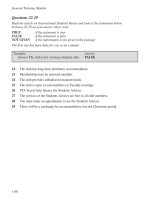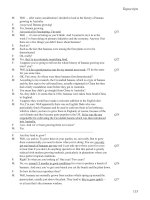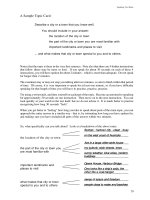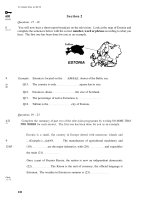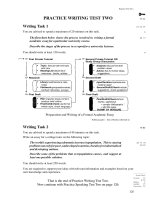101 helpful hints for ielts part 9
Bạn đang xem bản rút gọn của tài liệu. Xem và tải ngay bản đầy đủ của tài liệu tại đây (107.53 KB, 15 trang )
Practice Test Two
PRACTICE WRITING TEST TWO
Writing Task 1
You are advised to spend a maximum of 20 minutes on this task.
The flowchart below shows the process involved in writing a formal
academic essay for a particular university course.
Describe the stages of the process in a report for a university lecturer.
You should write at least 150 words.
Preparation and Writing of a Formal Academic Essay
: bibliography - list of books referred to
59-66
67-74-75
6
68 73
8
Writing Task 2
You are advised to spend a maximum of 40 minutes on this task.
Write an essay for a college tutor on the following topic:
The world is experiencing a dramatic increase in population. This is causing
problems not only for poor, undeveloped countries, but also for industrialised
and developing nations.
Describe some of the problems that overpopulation causes, and suggest at
least one possible solution.
You should write at least 250 words.
You are required to support your ideas with relevant information and examples based on your
own knowledge and experience.
75-82
60 77 79
80 82
That is the end of Practice Writing Test Two.
Now continue with Practice Speaking Test Two on page 126.
Overall Check.
Grammar
&
Spelling
Legibility
Punctuation
12
65
4
15
59
125
First Private Tutorial
Topic: discuss task and topic
with tutor
Reading List: obtain list of
resources - books, articles
Research
Library: read literature, take
notes
Field work: give questionnaires,
conduct interviews, surveys
First Draft
Plan: organise essay content,
produce brief outline
First Draft & Check: use formal
written style, check language
Second Private Tutorial OR
Study Group Discussion
Analysis: discuss first draft
problem areas
Advice: Ask for further ideas,
suqqestions
Second Draft
Input Revision: read resource
material again
Second Draft & Check: include
suggestions, check quotations
Final Draft
Final Draft & Check: do final
rewrite, spellcheck
+ compile bibliography *
+ add title page
SUBMIT BY DEADLINE
83-86
8
101 Helpful Hints for IELTS
PRACTICE SPEAKING TEST TWO
Practise answering the questions below, giving answers that are at least one or two sentences
long (if not more). If possible, practise with another person - taking it in turns to answer the same
question - and compare your responses.
(Please note that the following questions are only a guide to the type of questions you might be
asked in the actual test.)
87-91 Part 1
Please come in and sit down - over here. First, let me take a look at your passport.
... it's for security purposes only.
Thank you. My name is (interviewer's name). What is your name?
Where do you come from?
Tell me about your family. What do your family members do for a living?
What do you and your family like to do together?
Where do you live now?
What kind of place do you live in (a house or a flat)?
Describe the neighbourhood that you live in at the moment.
Have you ever had a full-time job? If you have, tell me about it.
What are (or were) the advantages and disadvantages of this job?
Have you ever had a part-time or casual job?
Did you enjoy your time at school? Tell me what you liked and what you didn't like.
Are you studying at the moment? If so, what are you studying and where?
What do you find most difficult about your study and why?
What is your favourite pastime? Why do you enjoy doing this?
Do you prefer indoor or outdoor activities? Why?
Do you belong to any clubs? If so, why did you join.
Do you read much? What do you like to read?
What else do you like to do in your spare time?
126
Practice Test Two
Part 2
Thank you. Now, please take this card. I want you to speak for one or two minutes about the
topic written on this card. Follow the instructions on the card. You have one minute to prepare
before you give your talk.
92-94
Describe a person who has had a major influence on you.
You should include in your answer:
who that person is and what he or she looks like
how you first met
his or her special qualities and characteristics
... and why that person is so important in your life.
8 95
Part 3 (begins after one or two follow-up questions on the talk above)
Thank you. Please give me back the card. People are so interesting.
How do you think people's attitudes to life have changed over the last hundred years or so?
How is your behaviour different to your parents' behaviour?
What do you think has caused these changes - why have people changed so much?
How is modern life better than in the past?
In what ways was life better in the past?
Describe the main problems that people face living in the modern world.
Are there any solutions to these problems?
Do you think the way we live will continue to change in the future? In what way?
What do you think will be the greatest influence on young people in the future?
... and what are the greatest dangers that young people will face?
Who are the best role models for young people these days?
That is the end of the interview. Thank you and goodbye.
95-99
That is the end of Practice Speaking Test Two.
Check your answers to Practice Test Two with the Answer Key on page 160.
100-101
Overall Check
What To Do and
What Not To Do
88-93-96-101
127
101 Helpful Hints for IELTS
During Test:
6-10-37
38-44
54-56-57
6
8
26-27
9
13
i PRACTICE READING TEST THREE
Reading Passage 1
Questions 1-5
You should spend about 8 minutes on Questions 1-5.
Refer to Reading Passage 1 "Sugar and Other Sweeteners", and look at Questions 1-5 below.
Write your answers in boxes 1 - 5 on your Answer Sheet. The first one has been done for you
as an example.
Example: What do the letters HFCS stand for?
Q1/Q2. There are TWO naturally occurring sugar substances mentioned in
the article other than sucrose. What are they?
44
Q3. What does the food industry consider to be the perfect sweetener?
13 • 54 Q4/Q5. Name the TWO most recent artificial sweeteners listed in Figure 1.
The sweetness of a substance results from
physical contact between that substance and
the many thousand taste buds of the tongue.
The taste buds are clustered around several
hundred small, fleshy protrusions called taste
papilla which provide a large surface area for
the taste buds and ensure maximum contact
with a substance.
Although there are many millions of olfactory
cells in the nose, taste is a more intense
experience than smell; food technologists
believe this is because of the strong pleasure
relationship between the brain and food. And
it is universally acknowledged that sweetness
is the ultimate pleasurable taste sensation.
However, no-one is exactly sure what makes
a substance sweet.
Nature is abundant with sweet foodstuffs, the
most common naturally occurring substance
beingfructose, found in almost all fruits and
berries, and being the main component of
honey. Of course, once eaten, all foods
provide one or more of the three basic food
components - protein, fat and carbohydrate -
which eventually break down (if and when
required) to supply the body with the essential
sugar glucose.
Nature also supplies us with sucrose, a
naturally occurring sugar within the sugar
cane plant, which was discovered many
centuries BC. Sucrose breaks down into
glucose within the body. Nowadays, white
sugar is the food industry standard taste for
sugar - the benchmark against which all other
128
Practice Test Three
sweet tastes are measured.
In the U.S. A., foods and especially soft drinks,
are commonly sweetened with High Fructose
Corn Syrup (HFCS) derived from corn starch
by a process developed in the late 1960s.
In addition to nature's repertoire, man has
developed a dozen or so artificial sweetening
agents that are considered harmless, non-
active chemicals with the additional property
of sweetness (see Figure 1.)
There is, indeed, an innate desire in humans
(and some animals) to seek out and enjoy
sweet-tasting foods. Since sweet substances
provide energy and sustain life they have
always been highly prized. All food
manufacturers capitalise on this craving for
sweetness by flavouring most processed foods
with carefully measured amounts of sugar in
one form or another. The maximum level of
sweetness that can be attained before the
intrinsic taste of the original foodstuff is lost
or unacceptably diminished is, in each case,
determined by trial and error.
Further, the most acceptable level of
sweetness for every product - that which
produces the optimum amount of pleasure
for most people - is surprisingly constant,
even across different cultures. This probably
goes a long way towards explaining the almost
universal appeal of Coca-Cola. (Although
the type of sugar used in soft drinks differs
across cultures, the intensity and, therefore,
pleasure invoked by such drinks remains
fixed within a fairly narrow range of
agreement.)
Artificial sweeteners cannot match the
luxurious smoothness and mouth-feel of white
sugar. Even corn syrup has a slightly lingering
after-taste. The reason why food technologists
have not yet been able to create a perfect
alternative to sucrose (presumably a non
kilojoule-producing substitute) is simple.
There is no molecular structure yet known
that predisposes towards sweetness. In fact,
there is no way to know for certain if a
substance will taste sweet or even taste of
anything at all. Our current range of artificial
sweeteners were all discovered to be sweet
purely by accident.
Sweetener
Sorbitol
Sucrose
High Fructose Corn Syrup
Cyclamate
Aspartame (NutraSweet)
Saccharin
relative to sucrose
strength
0.6
1.0
1.0
30
200
300
- base 1.0
** a mixture of fructose and glucose
Taste
slightly oily
When Discovered
1872
(France)
standard pre - 400 BC? (India?)
slight after-taste
sickly
close to sucrose
but softer, thinner
1960s
1937
1965
slightly bitter after-taste 1878
(USA)
(USA)
(USA)
(Germany)
Figure 1. Commercial Sweeteners
129
6
8
43-47
55-56
101 Helpful Hints for IELTS
Questions 6-15
You are advised to spend about 12 minutes on Questions 6-15.
The paragraphs below summarise Reading Passage 1 "Sugar and Other Sweeteners". Choose
ONE appropriate word from the box below to complete each blank space. Write your answers
in boxes 6 -15 on your Answer Sheet. The first one has been done for you as an example.
Note that NO WORD CAN BE USED MORE THAN ONCE.
9
7-12-44
Sugar tastes sweet because of thousands of receptors on the tongue which connect
the substance with the brain. The taste of sweetness is universally
...(Ex:)..&€6£0&(. as the most pleasurable known, although it is a (6)
why a substance tastes sweet (7) is the most abundant naturally occurring
sugar, sources of which include (8) and honey. Sucrose, which supplies
(9) to the body, is extracted from the sugar-cane plant, and white sugar (pure
sucrose) is used by food (10) to measure sweetness in other
(11) Approximately a dozen artificial sweeteners have been (12)....;
one of the earliest was Sorbitol from France.
Manufacturers add large amounts of sugar to foodstuffs but never more than the
(13) required to produce the optimum pleasurable taste. Surprisingly, this
amount is (14) for different people and in different cultures. No-one has yet
discovered a way to predict whether a substance will taste sweet, and it was by
chance alone that all the man-made (15) sweeteners were found to be sweet.
Check
11-15
glucose
w technology
"** artificially
commonly
*!»'• substances
fruit
sweetened
fructose
technologists
chemical
discovered
chemist
different
mystery
maximum
best
accepted
similar
130

